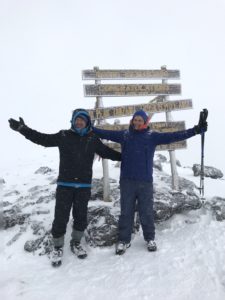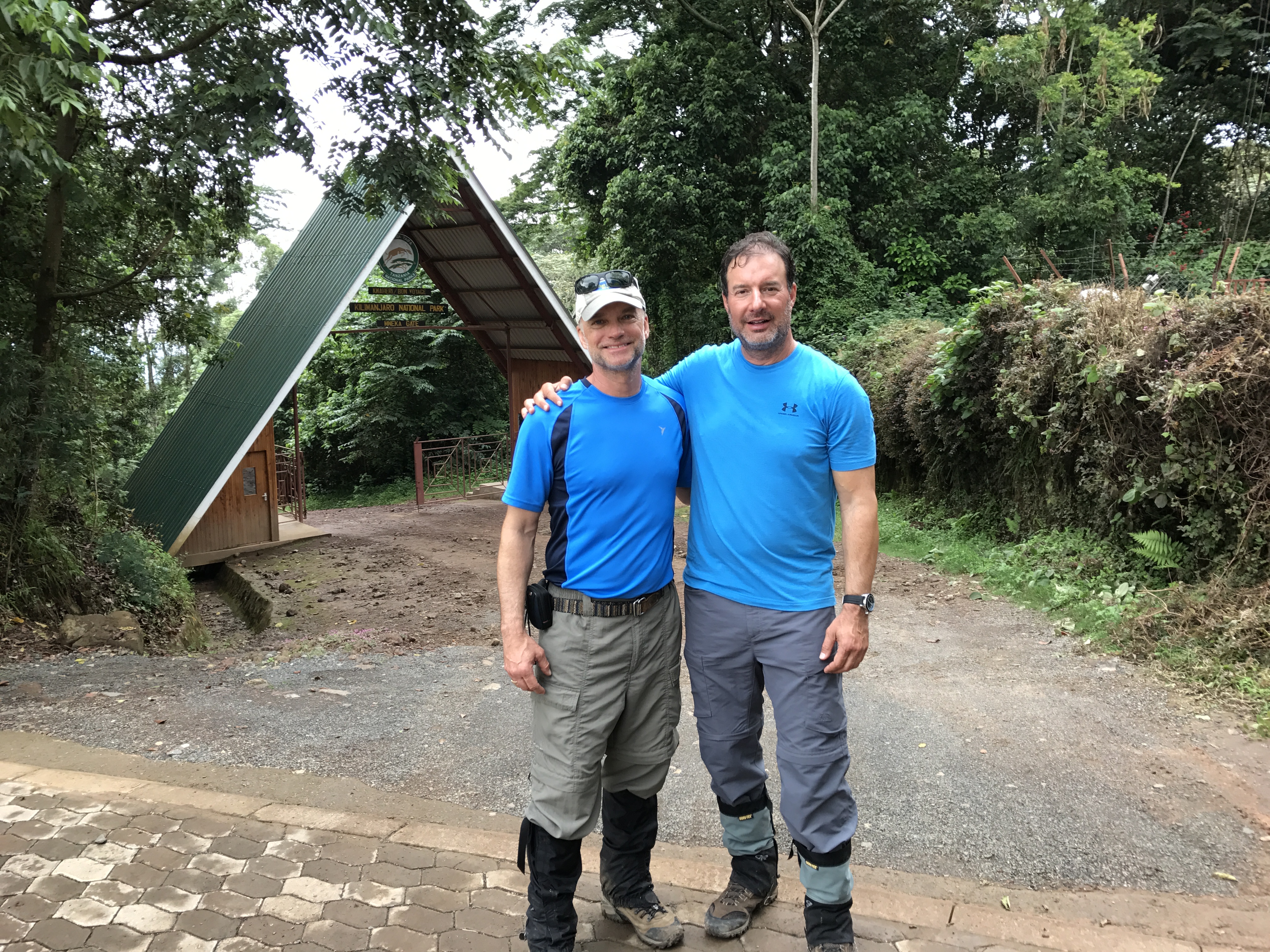The Journey
 Africa’s Mount Kilimanjaro has an elevation of 19,341 feet. Though Durfee knew he was in excellent physical shape, his greater concerns revolved around altitude changes. Being a Florida resident meant there weren’t any opportunities to train for that and altitude sickness can be quite severe, even leading to death if not addressed quickly.
Africa’s Mount Kilimanjaro has an elevation of 19,341 feet. Though Durfee knew he was in excellent physical shape, his greater concerns revolved around altitude changes. Being a Florida resident meant there weren’t any opportunities to train for that and altitude sickness can be quite severe, even leading to death if not addressed quickly.
On April 16, Durfee, Lightman and 10 others began their journey up the mountain accompanied by 42 porters and guides. Not only were the friends the only climbers from America, they were also the oldest in their group by as much as 38 years. With built up stress and anxiety from the weeks leading up to the trip, Lightman says he, too, was concerned about altitude sickness and injuring himself on the climb.
“I didn’t want to go all the way to Tanzania and have to come home and tell my four sons and wife that I wasn’t able to make it,” he says.
There are more than a half dozen routes to reach the summit, and the men opted for one of the more strenuous paths. “People often think Kilimanjaro is a mountain that can be hiked,” Durfee says. “Though we didn’t use ropes and or pick axes, at times we were actually climbing. The path got fairly steep.”
In addition to the obvious obstacles, Durfee held one very big consideration. He suffers from acrophobia, the fear of heights. To prepare for the trip, he decided it would be best to see a clinical hypnotherapist.
“There wasn’t much time to contemplate if I was truly scared of the heights while on my journey,” Durfee says. “You’re so focused on making the climb and enduring the weather, there’s really no space to wonder.”
He postulates the real test will be if he can endure a 4th floor hotel balcony for more than few seconds later this year.
“Truly this trip was about the element of testing myself both mentally and physically,” Durfee says. Proclaiming his adventure as the most challenging thing he’s ever done, the men were pleasantly surprised at how social the trip became as well. They bonded with their teammates quite quickly.
It took the group four days to reach the summit, starting out at 90 degrees Fahrenheit through the forest, traversing rainforest and wet conditions into a barren volcanic wasteland with temps well below 0. After hiking all day, the team reached base camp on April 19. With anticipation mounting for their final ascent to the summit, the guides conducted their daily oxygen level and heart rates on the climbers and instructed them to catch a few hours of sleep.
An Unexpected Obstacle
[metaslider id=12648]
It’s standard for teams to depart at midnight for the one-mile, 7.5-hour climb to the peak of Mount Kilimanjaro. Though they heard thunder earlier in the evening, everyone assumed the storm would blow past. With headlights on, the men began their last leg. Suddenly, rain turned to sleet, which turned into a heavy blizzard with 40+ mph winds and snow blowing sideways.
“The snow was so hard, we couldn’t define the path and it became very unsafe,” Durfee says. “We were actually inside the storm cloud and the lightning strikes were so loud, it seemed as though we were in the middle of what I imagine artillery fire must sound like.”
The men trudged forward. Every few moments lightning would strike so close and flash so rapid they actually saw it hit the side of the mountain. Afterward, several would share that the hair on their head actually stood up from the electric strikes.
Finally the team topped the mountain. In other times of the year, climbers would enjoy the morning sunrise, but with this 1/50 chance storm, the team had no such luck.
“There’s a combination of feelings when you finally reach the top,” Durfee says. “Of course, there’s that feeling of accomplishment, but it’s somewhat tempered because you’ve extended so much energy, both physical and mental, that you’re just zapped. There is that wonderful feeling, it’s just not prolonged.”
In addition, the blizzard was still blowing and the team had to traverse back down the mountain safely as well.
Dedicated to Dad
 Durfee and Lightman dedicated this adventure to their fathers. With one final surprise to commemorate the moment, Durfee had worn one of his dad’s old ties under all of his layers. He celebrated his dad by displaying the tie proudly in his victorious picture at the summit marker. Lightman thought of his dad and wished he were still alive to do the adventure with him.
Durfee and Lightman dedicated this adventure to their fathers. With one final surprise to commemorate the moment, Durfee had worn one of his dad’s old ties under all of his layers. He celebrated his dad by displaying the tie proudly in his victorious picture at the summit marker. Lightman thought of his dad and wished he were still alive to do the adventure with him.
“The sub-zero weather, with lightning striking all around, gave me the extra adrenaline I needed to make it to the top,” Lightman says. He explains the feeling of reaching the summit in one word: euphoria.
Both men learned more about themselves during their journey.
“I know that I can push myself and be successful,” Durfee says. “I’ve never been so close to collapse before. I learned I pretty much maxed out on the adventures I can take in the future. I’m not disappointed in that. I’m satisfied.”
Lightman adds, “Pushing yourself well beyond your own expectations is a self-actualizing experience that everyone should do at least once in their life. Challenging your physical and mental self-imposed limitations takes you out of your comfort zone and allows for an organic paradigm shift of your typical thought processes and perspectives.”
They agree that this out-of-the-box experience was unlike anything they had ever done. As Lightman says, they met an extreme challenge head one and successfully accomplished their goal of making it to the top and getting back down in one piece.





Comments